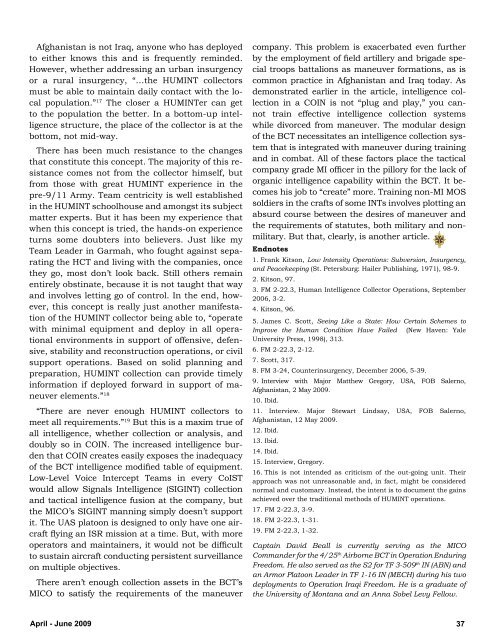Military Intelligence Professional Bulletin - Federation of American ...
Military Intelligence Professional Bulletin - Federation of American ...
Military Intelligence Professional Bulletin - Federation of American ...
Create successful ePaper yourself
Turn your PDF publications into a flip-book with our unique Google optimized e-Paper software.
Afghanistan is not Iraq, anyone who has deployed<br />
to either knows this and is frequently reminded.<br />
However, whether addressing an urban insurgency<br />
or a rural insurgency, “…the HUMINT collectors<br />
must be able to maintain daily contact with the local<br />
population.” 17 The closer a HUMINTer can get<br />
to the population the better. In a bottom-up intelligence<br />
structure, the place <strong>of</strong> the collector is at the<br />
bottom, not mid-way.<br />
There has been much resistance to the changes<br />
that constitute this concept. The majority <strong>of</strong> this resistance<br />
comes not from the collector himself, but<br />
from those with great HUMINT experience in the<br />
pre-9/11 Army. Team centricity is well established<br />
in the HUMINT schoolhouse and amongst its subject<br />
matter experts. But it has been my experience that<br />
when this concept is tried, the hands-on experience<br />
turns some doubters into believers. Just like my<br />
Team Leader in Garmah, who fought against separating<br />
the HCT and living with the companies, once<br />
they go, most don’t look back. Still others remain<br />
entirely obstinate, because it is not taught that way<br />
and involves letting go <strong>of</strong> control. In the end, however,<br />
this concept is really just another manifestation<br />
<strong>of</strong> the HUMINT collector being able to, “operate<br />
with minimal equipment and deploy in all operational<br />
environments in support <strong>of</strong> <strong>of</strong>fensive, defensive,<br />
stability and reconstruction operations, or civil<br />
support operations. Based on solid planning and<br />
preparation, HUMINT collection can provide timely<br />
information if deployed forward in support <strong>of</strong> maneuver<br />
elements.” 18<br />
“There are never enough HUMINT collectors to<br />
meet all requirements.” 19 But this is a maxim true <strong>of</strong><br />
all intelligence, whether collection or analysis, and<br />
doubly so in COIN. The increased intelligence burden<br />
that COIN creates easily exposes the inadequacy<br />
<strong>of</strong> the BCT intelligence modified table <strong>of</strong> equipment.<br />
Low-Level Voice Intercept Teams in every CoIST<br />
would allow Signals <strong>Intelligence</strong> (SIGINT) collection<br />
and tactical intelligence fusion at the company, but<br />
the MICO’s SIGINT manning simply doesn’t support<br />
it. The UAS platoon is designed to only have one aircraft<br />
flying an ISR mission at a time. But, with more<br />
operators and maintainers, it would not be difficult<br />
to sustain aircraft conducting persistent surveillance<br />
on multiple objectives.<br />
There aren’t enough collection assets in the BCT’s<br />
MICO to satisfy the requirements <strong>of</strong> the maneuver<br />
company. This problem is exacerbated even further<br />
by the employment <strong>of</strong> field artillery and brigade special<br />
troops battalions as maneuver formations, as is<br />
common practice in Afghanistan and Iraq today. As<br />
demonstrated earlier in the article, intelligence collection<br />
in a COIN is not “plug and play,” you cannot<br />
train effective intelligence collection systems<br />
while divorced from maneuver. The modular design<br />
<strong>of</strong> the BCT necessitates an intelligence collection system<br />
that is integrated with maneuver during training<br />
and in combat. All <strong>of</strong> these factors place the tactical<br />
company grade MI <strong>of</strong>ficer in the pillory for the lack <strong>of</strong><br />
organic intelligence capability within the BCT. It becomes<br />
his job to “create” more. Training non-MI MOS<br />
soldiers in the crafts <strong>of</strong> some INTs involves plotting an<br />
absurd course between the desires <strong>of</strong> maneuver and<br />
the requirements <strong>of</strong> statutes, both military and nonmilitary.<br />
But that, clearly, is another article.<br />
Endnotes<br />
1. Frank Kitson, Low Intensity Operations: Subversion, Insurgency,<br />
and Peacekeeping (St. Petersburg: Hailer Publishing, 1971), 98-9.<br />
2. Kitson, 97.<br />
3. FM 2-22.3, Human <strong>Intelligence</strong> Collector Operations, September<br />
2006, 3-2.<br />
4. Kitson, 96.<br />
5. James C. Scott, Seeing Like a State: How Certain Schemes to<br />
Improve the Human Condition Have Failed (New Haven: Yale<br />
University Press, 1998), 313.<br />
6. FM 2-22.3, 2-12.<br />
7. Scott, 317.<br />
8. FM 3-24, Counterinsurgency, December 2006, 5-39.<br />
9. Interview with Major Matthew Gregory, USA, FOB Salerno,<br />
Afghanistan, 2 May 2009.<br />
10. Ibid.<br />
11. Interview. Major Stewart Lindsay, USA, FOB Salerno,<br />
Afghanistan, 12 May 2009.<br />
12. Ibid.<br />
13. Ibid.<br />
14. Ibid.<br />
15. Interview, Gregory.<br />
16. This is not intended as criticism <strong>of</strong> the out-going unit. Their<br />
approach was not unreasonable and, in fact, might be considered<br />
normal and customary. Instead, the intent is to document the gains<br />
achieved over the traditional methods <strong>of</strong> HUMINT operations.<br />
17. FM 2-22.3, 3-9.<br />
18. FM 2-22.3, 1-31.<br />
19. FM 2-22.3, 1-32.<br />
Captain David Beall is currently serving as the MICO<br />
Commander for the 4/25 th Airborne BCT in Operation Enduring<br />
Freedom. He also served as the S2 for TF 3-509 th IN (ABN) and<br />
an Armor Platoon Leader in TF 1-16 IN (MECH) during his two<br />
deployments to Operation Iraqi Freedom. He is a graduate <strong>of</strong><br />
the University <strong>of</strong> Montana and an Anna Sobel Levy Fellow.<br />
April - June 2009 37
















